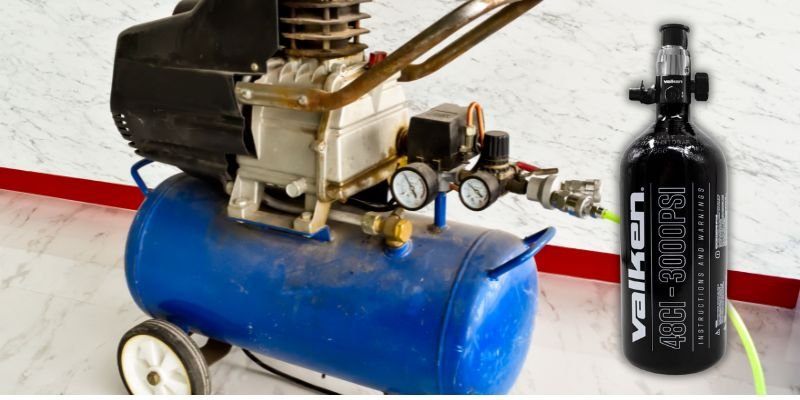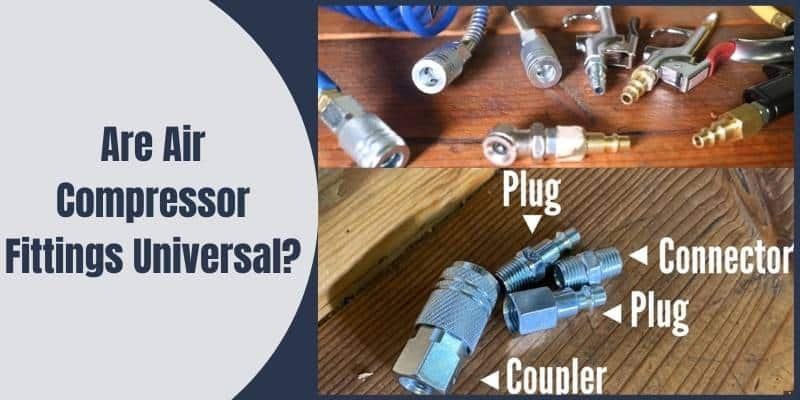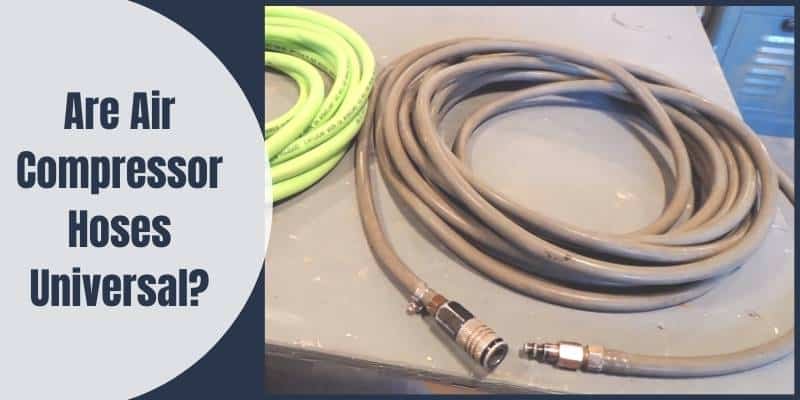Disclosure: This post contains affiliate links and I will be compensated if you make a purchase after clicking through my links. Learn More
If you are an avid paintball or airsoft enthusiast, you probably understand the importance of having a fully charged High-Pressure Air (HPA) tank for an uninterrupted gaming experience.
The question that often arises among players is, “Can You Fill HPA Tank with Air Compressor?” This guide aims to address this query and provide valuable insights on the subject matter.

Can You Fill HPA Tank with Air Compressor?
The answer is yes; you can fill an HPA tank with an air compressor, but certain crucial steps must be followed to ensure a safe and efficient process. Proper equipment, knowledge, and adherence to safety guidelines are essential to avoid any potential hazards and maintain the longevity of your HPA tank.
Understanding HPA Tanks
HPA tanks, or High-Pressure Air tanks, are used to store compressed air for various purposes. These tanks are commonly used in paintball guns, airsoft guns, and other applications where a high-pressure air source is required. There are different types of HPA tanks available, including aluminum HPA tanks and fiber-wrapped HPA tanks.
Aluminum HPA tanks are made from aluminum and are relatively inexpensive compared to other types of HPA tanks. These tanks are lightweight and come in different sizes. However, they have a limited lifespan and need to be hydrotested every few years.
Fiber-wrapped HPA tanks, on the other hand, are made from carbon fiber and are more expensive than aluminum tanks. These tanks are lighter and have a higher capacity than aluminum tanks. They also have a longer lifespan and do not need to be hydrotested as frequently as aluminum tanks.
When filling an HPA tank, it is important to use a compressor that is designed for this purpose. Using a regular air compressor can damage the tank and cause it to rupture. It is also important to follow the manufacturer’s instructions for filling the tank and to use the correct pressure.
In summary, HPA tanks are an essential component of many air-powered devices. There are different types of HPA tanks available, including aluminum and fiber-wrapped tanks. It is important to use the correct compressor and follow the manufacturer’s instructions when filling the tank to ensure safe and efficient operation.
Air Compressors and Their Role
Air compressors are an essential tool for filling high-pressure air tanks. They work by compressing air and storing it in a tank until it is needed. The air compressor is powered by a motor that uses electricity or gas to run.
The power of an air compressor is measured in horsepower (HP). The higher the HP, the more powerful the air compressor is. The air pressure that an air compressor can produce is measured in pounds per square inch (PSI). The volume of air that an air compressor can produce is measured in cubic feet per minute (CFM).
A regular air compressor typically produces air pressure between 125 and 175 PSI. This is sufficient for most applications, including filling small air tanks. However, for high-pressure air tanks, a high-pressure air compressor is required. These types of air compressors can produce air pressure up to 4500 PSI.
When selecting an air compressor, it is important to consider the power source. Some air compressors are powered by electricity, while others are powered by gas. Electric air compressors are more convenient to use, but gas-powered air compressors are more powerful.
In conclusion, air compressors play a crucial role in filling high-pressure air tanks. They are available in various sizes and power options to suit different needs. When selecting an air compressor, it is important to consider the power, air pressure, and volume of air that it can produce, as well as the power source.
How to Fill HPA Tank With Air Compressor
Filling an HPA tank can be done using an air compressor. Here is the process of how to fill HPA tank with air compressor: Step by step guide.
Connect the hose: Connect the hose from the fill station to the nozzle of the HPA tank. Ensure that the connections are secure to avoid any leaks.
Open the valve: Open the valve on the fill station to allow air to flow into the HPA tank.
Monitor the pressure: Monitor the pressure gauge on the HPA tank to ensure that it is filling up to the desired pressure.
Close the valve: Once the desired pressure is reached, close the valve on the fill station to stop the flow of air.
Disconnect the hose: Disconnect the hose from the nozzle of the HPA tank and replace the cap.
It is important to note that not all air compressors are suitable for filling HPA tanks. Portable air compressors may not have the capacity to fill HPA tanks to the desired pressure. It is recommended to use a fill station that is specifically designed for filling HPA tanks.
In summary, filling an HPA tank with an air compressor involves connecting the hose, opening the valve, monitoring the pressure, closing the valve, and disconnecting the hose. It is important to use a suitable air compressor and fill station to ensure safe and efficient filling of the HPA tank.
Monitoring and Control Measures
When filling an HPA tank with an air compressor, it is essential to monitor the pressure levels to ensure that the tank is not overfilled or underfilled. This can be achieved through the use of pressure gauges, which provide accurate readings of the pressure inside the tank.
A gauge can be installed on the compressor to monitor the pressure level during the filling process. This will help to prevent overfilling, which can cause damage to the tank and the compressor.
It is important to note that the pressure gauge should be calibrated regularly to ensure that it provides accurate readings.
In addition to pressure gauges, a pressure switch can be installed to control the pressure level during the filling process. The pressure switch will automatically shut off the compressor once the required pressure has been reached. This will help to prevent overfilling and ensure that the tank is filled to the correct pressure level.
It is also important to monitor the temperature of the compressor during the filling process. Overheating can cause damage to the compressor and the tank. A temperature monitor can be installed to ensure that the compressor does not overheat during the filling process.
Overall, monitoring and control measures are essential when filling an HPA tank with an air compressor. By using pressure gauges, pressure switches, and temperature monitors, you can ensure that the tank is filled to the correct pressure level without causing any damage to the tank or the compressor.
Safety Precautions While Filling HPA Tanks
When filling an HPA tank, it is important to take necessary safety precautions to avoid any potential hazards. Here are a few safety tips to keep in mind:
- Always wear proper safety equipment, such as safety glasses or goggles, to protect your eyes from any debris or shrapnel that may fly out during the filling process.
- Make sure to fill the tank in a well-ventilated area to prevent any buildup of fumes or gases that could potentially cause an explosion.
- Before filling the tank, inspect it for any signs of damage or wear and tear. If you notice any cracks or dents, do not attempt to fill the tank as it may rupture during the filling process.
- Use only the recommended filling equipment and follow the manufacturer’s instructions carefully. Do not attempt to modify or alter the equipment in any way.
- Keep a fire extinguisher nearby in case of any emergencies.
By following these safety measures, you can ensure a safe and successful filling of your HPA tank.
Potential Issues and Their Solutions
When filling an HPA tank with an air compressor, there are some potential issues that you may encounter. Here are some common problems and their solutions:
Leakage
One of the most common issues when filling an HPA tank is leakage. This can occur due to damaged o-rings, worn-out seals, or loose connections. If you notice any leakage, stop filling the tank immediately and inspect the tank and the compressor for any visible damage.
Tighten any loose connections and replace any damaged o-rings or seals. It’s essential to ensure that the tank and compressor are in good condition before attempting to fill the tank again.
Overfilling
Overfilling an HPA tank can cause the tank to rupture, which can be dangerous. It’s crucial to follow the manufacturer’s instructions and fill the tank to the recommended pressure.
Some compressors have an automatic shut-off feature that stops the filling process once the tank reaches the recommended pressure.
If your compressor doesn’t have this feature, you must monitor the pressure gauge closely and stop filling the tank once it reaches the recommended pressure.
Malfunction
If your compressor malfunctions while filling the HPA tank, it can cause damage to the tank or compressor. Make sure to inspect the compressor regularly and perform routine maintenance to avoid any malfunctions.
If you notice any signs of malfunction, such as unusual noises or vibrations, stop using the compressor immediately and seek professional help.
Moisture and Debris
Moisture and debris can accumulate in the HPA tank and compressor, which can cause damage and affect the performance of your equipment.
Make sure to use a high-quality air filter and drain the moisture regularly from the compressor. You can also use a desiccant filter to absorb any moisture in the air before it enters the compressor.
In summary, filling an HPA tank with an air compressor can be a convenient and cost-effective way to keep your tank filled.
However, it’s essential to be aware of the potential issues and take the necessary precautions to avoid any damage or accidents.
Regular maintenance and inspection of your equipment can help ensure that your tank and compressor are in good condition and perform optimally.
Role of Adapters and Fittings
When it comes to filling an HPA tank with an air compressor, adapters and fittings play a crucial role in ensuring a safe and efficient process.
Adapters are used to connect the air compressor to the HPA tank, while fittings are used to connect different parts of the system together.
One common type of adapter used in HPA tank filling is a DIN adapter. This adapter allows the user to connect the HPA tank to the air compressor using a DIN fitting.
Similarly, a paintball adapter can be used to connect the HPA tank to a paintball gun.
In addition to adapters, fittings are also important in the HPA tank filling process. For example, a nipple fitting can be used to connect the HPA tank to a regulator.
This fitting allows the user to control the pressure of the air going into the tank, which is important for safety reasons.
It is important to ensure that the adapters and fittings used in the HPA tank filling process are compatible with each other and with the equipment being used. Using incompatible parts can result in leaks, damage to equipment, or even injury.
Overall, adapters and fittings play a critical role in the safe and efficient filling of HPA tanks with an air compressor.
By ensuring that the right parts are used and that they are compatible with each other and with the equipment being used, users can enjoy a reliable and safe HPA tank filling experience.
Use of HPA Tanks in Paintball and Airsoft
HPA tanks, also known as high-pressure air tanks, are commonly used in paintball and airsoft as a power source for the guns. These tanks are filled with compressed air, which is then used to propel the paintball or BB out of the gun.
Paintball and airsoft players prefer HPA tanks over other power sources, such as CO2, due to their consistency and reliability.
HPA tanks maintain a consistent pressure throughout use, which results in more accurate shots and fewer misfires.
Additionally, HPA tanks are more environmentally friendly than CO2, as they do not release harmful gases into the atmosphere.
When using HPA tanks in paintball or airsoft, it is crucial to ensure that the tank is filled to the correct pressure level. Overfilling the tank can result in damage to the tank or gun, while underfilling can result in decreased accuracy and power.
Players can fill their HPA tanks using an air compressor, which is a convenient and cost-effective option. However, it is important to note that not all air compressors are suitable for filling HPA tanks.
Players should use compressors specifically designed for HPA tank filling and ensure that the compressor is capable of filling the tank to the correct pressure level.
In conclusion, HPA tanks are a reliable and consistent power source for paintball and airsoft guns. Players should take care to fill their tanks to the correct pressure level and use appropriate equipment for tank filling.
Maintenance of HPA Tanks
HPA tanks require regular maintenance to ensure they function properly and safely. Here are some important maintenance tips:
- Regular Inspection: Inspect your HPA tank regularly for any signs of damage, such as cracks, dents, or scratches. If you notice any damage, do not use the tank and have it inspected by a professional.
- Heat: Avoid exposing your HPA tank to excessive heat, as this can cause damage to the tank and compromise its safety. Do not leave your tank in direct sunlight or in a hot car.
- Lubricant: Use a high-quality lubricant specifically designed for HPA tanks to ensure smooth operation. Apply the lubricant to the o-rings and threads of the tank.
- O-rings: Inspect the o-rings on your HPA tank regularly for any signs of wear or damage. Replace any worn or damaged o-rings immediately to prevent leaks.
- Hydro Date: HPA tanks must be hydrotested every 5 years to ensure they are still safe to use. Check the hydro date on your tank and have it hydrotested before the expiration date.
By following these maintenance tips, you can ensure your HPA tank functions properly and safely for years to come.
Frequently Asked Questions
Can I use an air compressor to fill my paintball tank?
Yes, you can use an air compressor to fill your paintball tank, but you need to make sure that the compressor can provide the required pressure and volume of air.
Can you refill a CO2 tank with an air compressor?
Yes, you can refill a CO2 tank with an air compressor. Read more about how to refill CO2 tank with air compressor safely.
Where can I refill my HPA tank?
You can refill your HPA tank at a paintball field or shop that has a fill station, or at a scuba shop that offers HPA tank refills.
What is the maximum pressure an air compressor can fill?
The maximum pressure an air compressor can fill depends on the compressor’s specifications. Most compressors can fill up to 150-200 PSI, which is enough for most paintball tanks.
How long does it take to fill an HPA tank with an air compressor?
The time it takes to fill an HPA tank with an air compressor depends on the size of the tank and the compressor’s output. A typical 68 cubic inch HPA tank can take around 10-15 minutes to fill from empty.
Can a regular air compressor fill an HPA tank?
No, a regular air compressor cannot fill an HPA tank. HPA tanks require compressed air that is free of moisture and contaminants, which regular compressors cannot provide. You need a specialized compressor or a fill station to fill an HPA tank properly.


